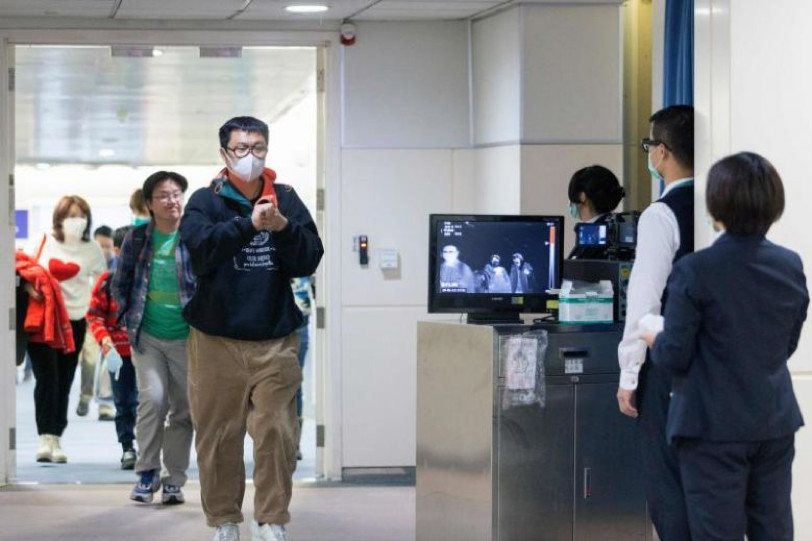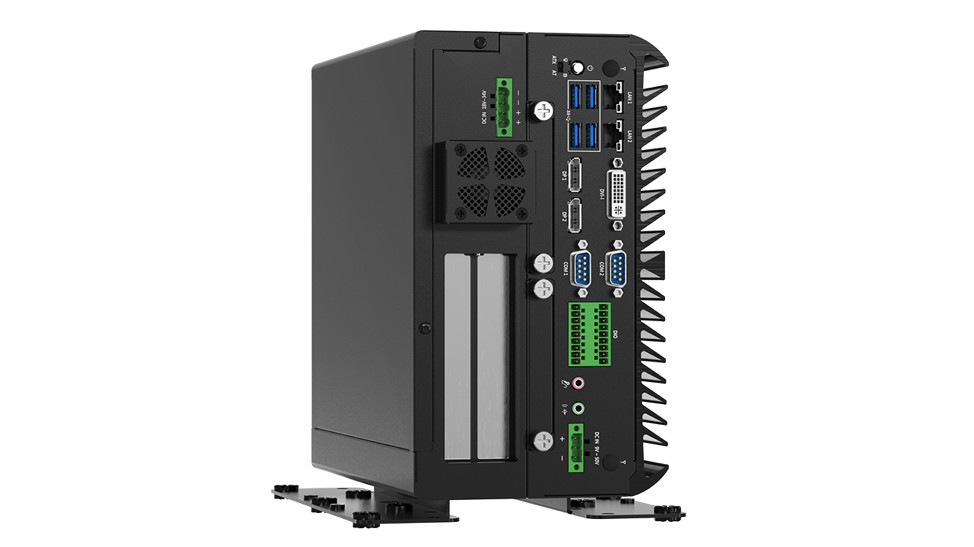Thermal Detection, Computer Vision Could Help Curve the Coronavirus Pandemic
April 08, 2020
News

Industrial GPU computers are now available with the performance and expandability to execute these neural network algorithms at the edge, enabling large-scale, contactless screening.
The coronavirus pandemic quickly overwhelmed the healthcare infrastructure of countries around the world. In the United States, for instance, the situation was exacerbated by the initial release of faulty test kits, which subsequently resulted in an inability to accurately screen potential patients for the disease.
However, there were also missed opportunities to pre-screen potential coronavirus carriers at ports of entry. Rather than surveying unsuspecting carriers about their recent travels, authorities like the Transportation Security Administration could have benefitted greatly from the use of AI-enabled computer vision technologies capable of detecting symptoms associated with COVID-19 – such as fevers and abnormal respiratory patterns – with high precision and in real time.
Industrial GPU computers are now available with the performance and expandability to execute these neural network algorithms at the edge, enabling large-scale, contactless screening that will help mitigate the spread of coronavirus and other potentially-lethal infectious diseases.
TAIWAN: A CASE STUDY IN DISEASE PREVENTION AND MITIGATION

Figure 1. Health officials at the Taoyuan International Airport in Taipei, Taiwan use thermal imaging to spot potential coronavirus carriers (Source: AFP).
Despite its proximity to the epicenter of the coronavirus outbreak, as of Mar. 30, Taiwan has reported fewer than 300 cases of the coronavirus and just two deaths. The country’s ability to curb the spread of the disease is attributed to measures put in place after the SARS epidemic, which include the use of temperature monitoring in airports to screen travelers for fever.
Of course, using airport or medical workers to physically take the temperature of each individual passenger in these high-density environments is unrealistic if not dangerous. First, it would provide a platform for exponential transmission of contagions between passengers and healthcare staff, especially given the shortage of protective surgical masks and gloves. Second, it would lead to bottlenecks that have recently resulted in seven-hour wait times at U.S. airports.
Instead, major airports in Taiwan use high-resolution thermal cameras and deep learning. Once the cameras capture infrared images of passengers, the imaging data is passed into systems like the Premio VCO-6020-1050TI or VCO-6022C-2PWR industrial GPU computers. Captured pixels are then processed by on-chip Intel® or NVIDIA® graphics engines, while multicore CPUs execute computer vision algorithms (Figures 1 and 2). In some cases, the algorithms for facial recognition can be deployed, thereby stopping problems before they occur. See more detail in the video.

Figure 1. The VCO-6020-1050TI from Premio, Inc. is based on 6th or 7th generation Intel® Core™, Pentium®, or Celeron® processors and an NVIDIA GeForce® GTX 1050 TI Graphics engine with 768 CUDA cores, enabling computer vision algorithm execution at the edge in a fanless, small form factor package that consumes roughly 50W (Source: Premio Inc.)

Figure 2. The Premio VCO-6022C-2PWR is based on 6th or 7th generation Intel® Core™, Pentium®, or Celeron® processors with Intel® HD Graphics 530/630 that deliver high-performance edge inferencing at roughly 75W power consumption in a fanless industrial package (Source: Premio, Inc.).
As shown in Figure 3, the CPU-GPU architecture decreases execution time, thermal generation, and allows the Premio VCO-6020-1050TI and VCO-6022C-2PWR platforms to consume just 50 and 75 W, respectively. The VCO-6022C-2PWR can supports graphics processors ranging up to the RTX 2060 Super GPU, delivering 2176 Nvidia CUDA Cores, which is sufficient for real-time machine inferencing.

Figure 3. Heterogeneous CPU-GPU architectures reduce execution time, power consumption, and thermal generation versus monolithic compute architectures, as depicted in this OpenCL-based thermal imaging application (Source: Dev, et al).
Another key consideration of these systems is the availability of fast memory and storage that allow the different compute elements to transition quickly from image processing to inferencing execution, or between the various layers of a neural network algorithm. Here, the up to 32 GB of onboard DDR4 SO-DIMM memory operate at up to 2133 MHz, which consumes less power than other available memory options while still transferring data quickly enough for the systems to execute in real-time.
Depending on the software stack and implementation, AI-based temperature monitoring solutions based on platforms like the VCO-6020-1050TI and VCO-6022C-2PWR are able to perform thermal inferencing against up to 200 subjects per minute while accurately detecting temperatures of 99.1ºF or above.
Keep in mind that all of this computation is performed directly at the edge and benefits from rugged industrial GPU computers.
MAXIMIZING THE VALUE OF FEVER DETECTION DATA
After a temperature monitoring system captures, processes, and analyzes passenger imaging data, the findings must be presented to officials in a usable, meaningful way. This is another advantage of the heterogeneous multicore architecture of systems like the VCO-6020-1050TI and VCO-6022C-2PWR, as CPU cores can be reserved to perform system management, control, and communications tasks.
For example, both platforms are capable of simultaneously driving multiple independent displays (three on the 6022C, six on the 6020) via DVI-I, DisplayPort, or HDMI ports. This allows officials to monitor outcome of the primary computer vision application and take necessary actions such as segregating travelers suspected of having fevers.
In the near future, however, these systems could be leveraged to deploy more large-scale intelligent health and travel initiatives. Ethernet, USB, and serial communications options on both platforms allow data from the scans to be integrated with information from other systems, such as an automated passport control (APC) machine.
In this scenario, a VCO-6020-1050TI or VCO-6022C-2PWR could drive between three and six APC or global entry systems at once while simultaneously running computer vision algorithms on imaging data from thermal cameras. The system could then correlate a positive fever inference with passenger travel information to determine if a person should be deemed of extremely high risk based on their recent destinations.
If more processing, storage, or networking functionality is needed for the deployment, the platform provides mini PCIe slots, two 2.5" HDD bays, and PCI/PCIe expansion (VCO-6022C-2PWR only). The platforms support wide -25ºC to +70ºC operating temperature ranges; are housed in extruded aluminum and heavy-duty metal packaging; and are wall- and DIN rail-mountable with front-facing I/Os.
And, if the temperature monitoring deployment requires a solution that can drive cameras as well, the RCO-6020-1050TI offers most of the same features as its VCO series counterparts as well as the ability to drive up to eight PoE-enabled devices (Figure 4).

Figure 4. The RCO-6020-1050TI leverages 6th or 7th generation Intel® Core™, Pentium®, or Celeron® processors, an NVIDIA® GeForce® GTX 1050 TI Graphics engine, and provides up to eight power over Ethernet (PoE) for driving cameras (Source: Premio Inc.)
Despite the advances in health screening taking place at airports and Taiwan and elsewhere across the globe, there is also room for improvement. Less sophisticated systems that rely solely on thermal imaging data have been criticized in recent weeks as not effectively capturing transiting coronavirus carriers, which is why there is now and will continue to be an increased emphasis on combining them with artificial intelligence at the edge.
Meanwhile, AI algorithms themselves also continue to advance in accuracy, efficiency, and even modality. For instance, Chinese researchers and academics are currently developing a neural network that identifies Tachypnea, an abnormal respiratory condition that is more easily correlated to COVID-19 than simple fever, with better than 95 percent accuracy at present.
As shown in the video below, the real-time abnormal respiratory pattern classification system is capable of executing on multiple subjects in real-time. After further refinement, it could provide another accurate, scalable way to test large numbers of subjects.
Regardless of the algorithm, society will require an influx of high-performance, low-power platforms capable of real-time inference execution at the edge. This has become even more apparent as potential solutions like “drive-up” testing have emerged with the lack of coronavirus testing kits.
Today, such solutions are available that will quickly justify the ROI, and return society to normal much more quickly than the alternative.




